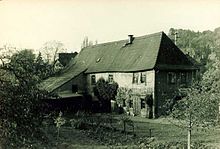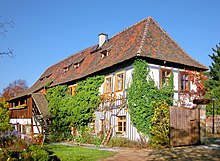House Lotter
House Lotter is one of the oldest winegrowers' houses in Lößnitz , it is located in the Niederlößnitz district of Radebeul in Winzerstraße 83 (the historic Hausgaß). It is named after the watchmaker Alfred Lotter, who set up and ran his workshop there in 1925/26 with the advice of the Saxon Homeland Security Association .
description



The half-timbered house , which is now listed as a historical monument, is also listed in the Dehio as a characteristic example of its kind, is divided into three adjoining structures under a shared hipped roof . This was originally covered with wooden shingles, which are now replaced by beaver tails . The building to the east, at the entrance to the gate, was built around 1580 and is shown on Matthias Oeder's map of the First Electoral Saxon State Record. It has studs going through both floors, but half-timbered on the ground floor only on the street side.
The two following, more recent construction phases can be recognized by a kink in the floor plan. The middle part of the building was determined by dendrochronological examination of the beams to the year of fall of the trees 1614, it shows typical post connections in the bundle of foot and head struts , while in the left older part only foot struts and in the younger right part only head struts can be seen. The most recent part that followed was added around 1700. Remnants of painting in, among other things, the winegrower's hall, the ballroom on the upper floor that spans the entire width of the house, can be narrowed down to the years 1650 (after the Kötzschenbroda armistice ) or 1710.
On the south side (courtyard side) there is a largely renewed arcade with covered stairs to access the upper floor. This was originally the only access to the upper floor, but more recently an inner staircase has been added. A wine press was set up on the ground floor and there was a black kitchen next to it .
The color scheme of the three-part building is based on the oldest verifiable color scheme. Thus, the black-gray bars of the oldest, eastern building are surrounded by a black line, while the bars in the middle are a lighter shade of gray. The youngest part in the west shows yellow bars with a red accompanying line.
history


House Lotter is one of the oldest buildings in the Loessnitz villages ; it is already shown on a map by the surveyor Matthias Oeder from around 1580 in the First Electoral Saxon Land Survey . The earliest purchase and inheritance contracts name a Schäffer family as owners in 1691, including the heirs of the clerk Conrad Schäffer zu Stolpen (presumably the clerk of the Stolpen office ), followed by some “senior military officers”. In the 18th and early 19th centuries, the winery owned two vineyards, the Hohe Berg and the Niedernberg , and around 1740 the "house, press and all accessories" and, through purchase, the "line". The sole owner, the royal Polish and electoral Saxon captain Christian Ehrenreich Schäffer (1718), who presumably used the property as a manorial summer residence, was inherited by his wife in 1752 and her six children in Dresden in 1787.
Christiane had married Dorothea in 1776. Shepherdess (Schäffer) born. Weinartin Neufriedstein acquired , which was sold to Georg Schwarz from Schäfferisches possession in 1827.
The year 1792 on a stone near the gate indicates another purchase within the family.
Around 1831, Lieutenant Colonel Scheffer (probably also belonging to the Schäffer family) sold to Johann Gottlob Talkenberg from Fürstenhain . Via Johann Christian David Thalheim (* 1816) in 1842 the property went to Johanna Christiane married in 1865. Thalheim geb. Talkenberg (1845–1925), then in 1886 to the Privatus Hermann Bäßler. Used by his widow (1897) Marie. In 1905, Bäßler passed the then fully plastered building to the blacksmith Theodor Lotter, whose son, the watchmaker Alfred Lotter, gave the house its name. He set up his workshop there in 1925/26 with advice from the Saxon Homeland Security Association and renewed the dilapidated enclosure wall. He took them back, including the gate, to today's line of flight, so that from there the footpath led to the entrance to his workshop.
The house was taken over in 1988 by an architect who lived and worked there until the 2010s. From 1988 to 1995, the listed, but heavily damaged building was professionally and historically renovated, for which the client received the 1998 Radebeul client award. In 2001, the client won recognition in the same competition in the category of open space and garden design.
In 2012, House Lotter was presented to the public for the Open Monument Day.
The house Lotter was home to 2014 also the seat of the club radebeul ev vereins for historic preservation and new building
At the end of 2017, after years of vacancy, the Lotter house was sold by the community of heirs of the architect Tilo Kempe, who died in 2015. With the sale, the Philipp family from Dresden became the new owners. The aim of the family is to preserve the historical building fabric as an actively used place of residence and as a holiday home, then in the rooms of the former workshop of the watchmaker Alfred Lotter (namesake of the house). Due to the musical orientation of the family members (Dresdner Kreuzchor), the winery, which was extensively renovated in the 1990s, is used again as a music room.
literature
- Frank Andert (Red.): Radebeul City Lexicon . Historical manual for the Loessnitz . Published by the Radebeul City Archives. 2nd, slightly changed edition. City archive, Radebeul 2006, ISBN 3-938460-05-9 .
- Matthias Donath, Jörg Blobelt (photos): Saxon wine country . Historic wineries and vineyard houses in the Elbe Valley. 1st edition. Editorial and publishing company Elbland, Dresden 2010.
- Volker Helas (arrangement): City of Radebeul . Ed .: State Office for Monument Preservation Saxony, Large District Town Radebeul (= Monument Topography Federal Republic of Germany . Monuments in Saxony ). SAX-Verlag, Beucha 2007, ISBN 978-3-86729-004-3 .
- Liselotte Closer (Erarb.): Radebeul - City guide through the past and present . 1st supplemented edition. Edition Reintzsch, Radebeul 2008, ISBN 978-3-930846-05-4 .
- Georg Wulff; et al. (Red.): Winegrowers' houses in Radebeul . In: Association for Monument Preservation and New Building Radebeul (ed.): Contributions to the urban culture of the city of Radebeul . Radebeul 2003 ( online table of contents, there the link to House Lotter ).
Web links
- Manfred Richter: House Lotter. In: Niederlößnitz from yesteryear. Retrieved August 17, 2012 .
- Photo before 1925. From: Landesverein Sächsischer Heimatschutz, Issue 5 to 6, Fig. 2, p. 174, Dresden 1925.
Individual evidence
- ^ Large district town of Radebeul (ed.): Directory of the cultural monuments of the town of Radebeul . Radebeul May 24, 2012, p. 39 (Last list of monuments published by the city of Radebeul. The Lower Monument Protection Authority, which has been located in the Meißen district since 2012, has not yet published a list of monuments for Radebeul.).
- ↑ Barbara Bechter, Wiebke Fastenrath u. a. (Ed.): Handbook of German Art Monuments , Saxony I, Dresden District . Deutscher Kunstverlag, Munich 1996, ISBN 3-422-03043-3 , p. 730-739 .
- ↑ a b c Liselotte Closer (Erarb.): Radebeul - City guide through past and present . 1st supplemented edition. Edition Reintzsch, Radebeul 2008, ISBN 978-3-930846-05-4 , pp. 121 ff .
- ↑ Radebeuler Bauherrenpreis 1998. Category: Renovation, 3rd place In: Radebeuler Bauherrenpreis. Association for Monument Preservation and New Buildings, Radebeul, accessed on October 9, 2009 .
- ↑ Radebeuler Builder Award 2001. Category: Open space and garden design. In: Radebeuler builder award. Association for Monument Preservation and New Buildings, Radebeul, accessed on October 9, 2009 .
- ↑ Open Monument Day on Sunday, 9.9.2012 in Radebeul.
Coordinates: 51 ° 6 ′ 45 ″ N , 13 ° 37 ′ 49 ″ E

